park assist TOYOTA HIGHLANDER 2013 XU50 / 3.G Owners Manual
[x] Cancel search | Manufacturer: TOYOTA, Model Year: 2013, Model line: HIGHLANDER, Model: TOYOTA HIGHLANDER 2013 XU50 / 3.GPages: 684, PDF Size: 15.42 MB
Page 159 of 684
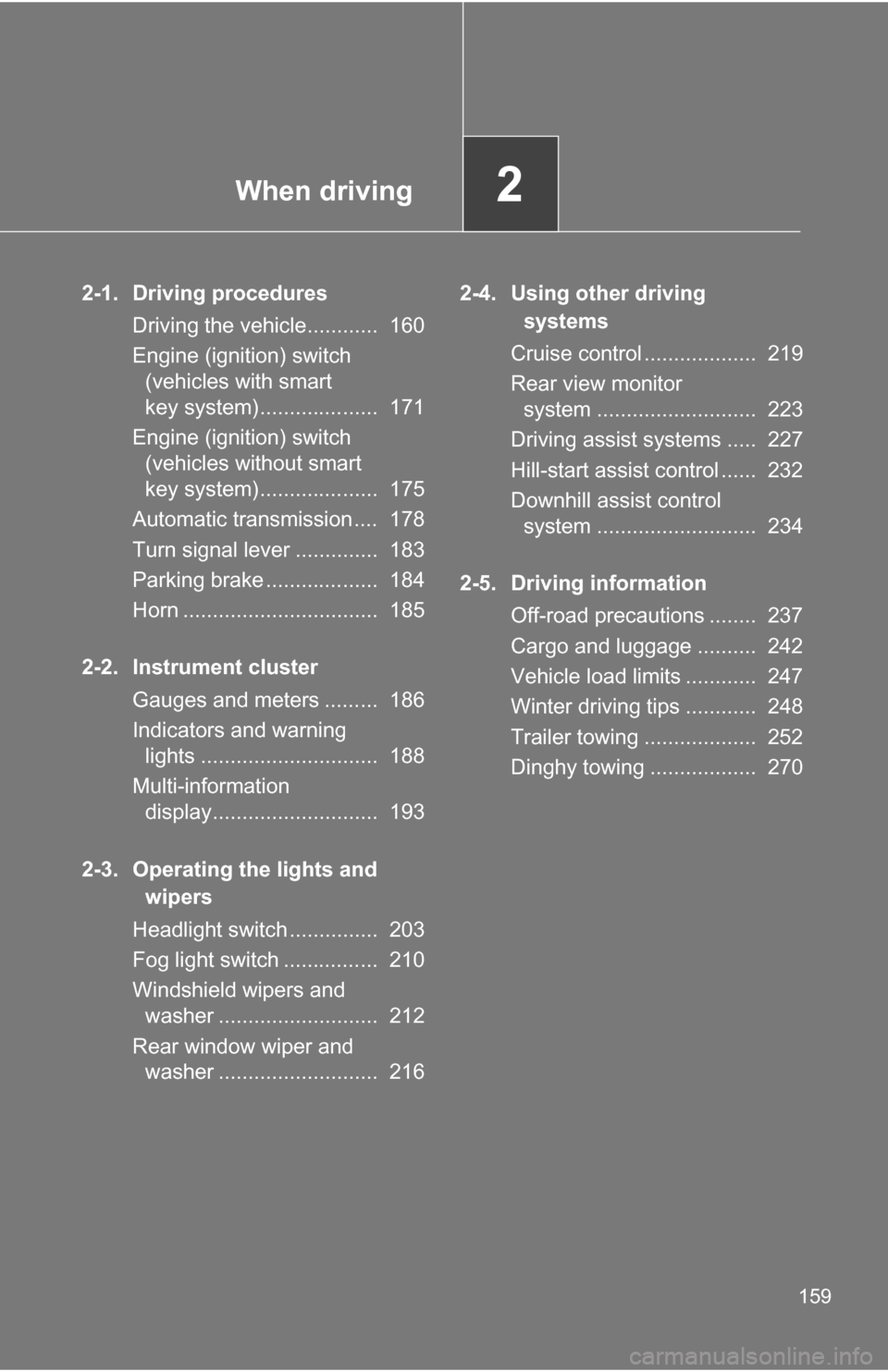
When driving2
159
2-1. Driving proceduresDriving the vehicle............ 160
Engine (ignition) switch (vehicles with smart
key system).................... 171
Engine (ignition) switch (vehicles without smart
key system).................... 175
Automatic transmission .... 178
Turn signal lever .............. 183
Parking brake ................... 184
Horn ................................. 185
2-2. Instrument cluster Gauges and meters ......... 186
Indicators and warning lights .............................. 188
Multi-information display............................ 193
2-3. Operating the lights and wipers
Headlight switch ............... 203
Fog light switch ................ 210
Windshield wipers and washer ........................... 212
Rear window wiper and washer ........................... 216 2-4. Using other driving
systems
Cruise control ................... 219
Rear view monitor system ........................... 223
Driving assist systems ..... 227
Hill-start assist control ...... 232
Downhill assist control system ........................... 234
2-5. Driving information Off-road precautions ........ 237
Cargo and luggage .......... 242
Vehicle load limits ............ 247
Winter driving tips ............ 248
Trailer towing ................... 252
Dinghy towing .................. 270
Page 164 of 684
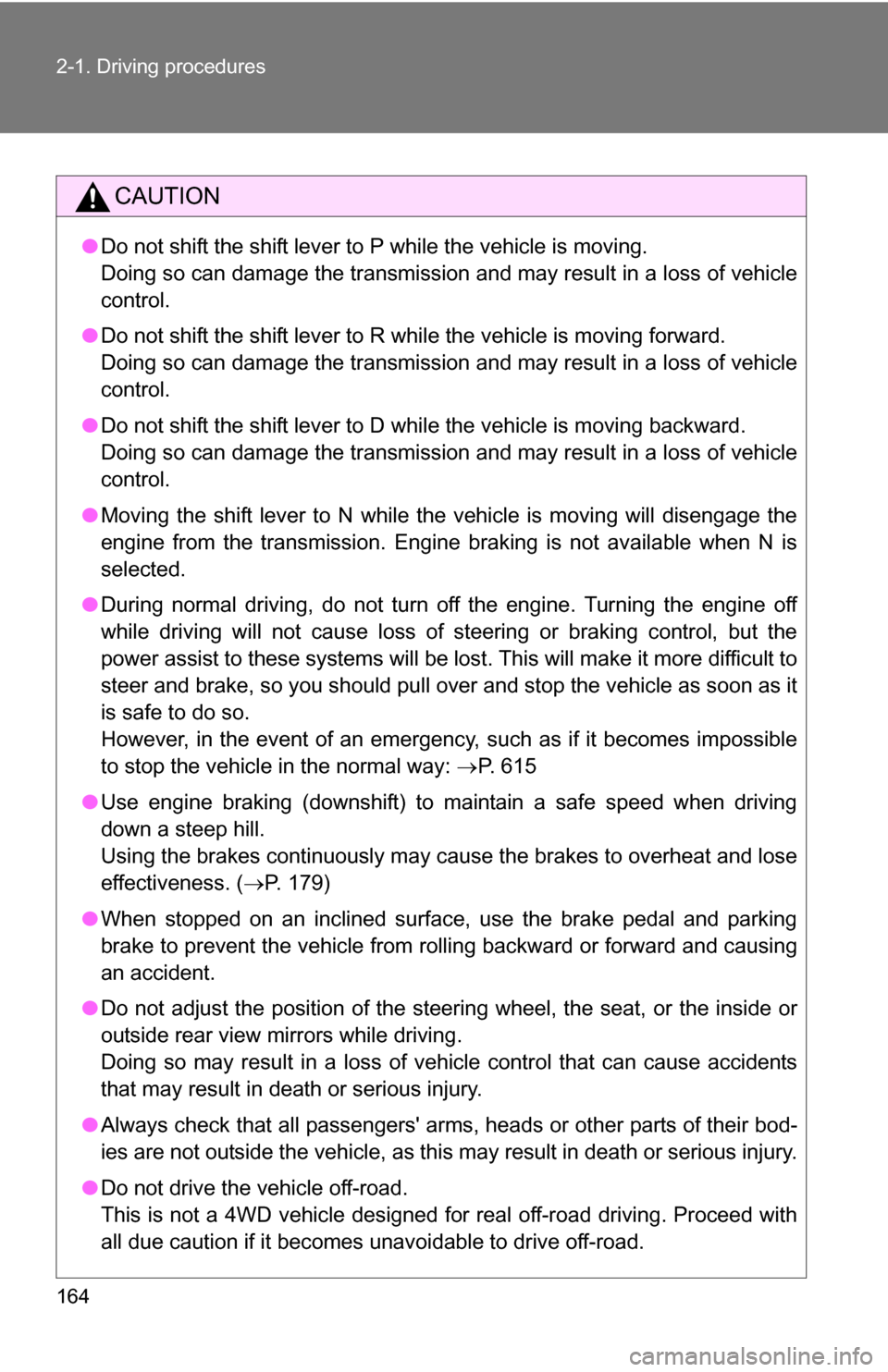
164 2-1. Driving procedures
CAUTION
●Do not shift the shift lever to P while the vehicle is moving.
Doing so can damage the transmission and may result in a loss of vehicle\
control.
● Do not shift the shift lever to R while the vehicle is moving forward.
Doing so can damage the transmission and may result in a loss of vehicle\
control.
● Do not shift the shift lever to D while the vehicle is moving backward.
Doing so can damage the transmission and may result in a loss of vehicle\
control.
● Moving the shift lever to N while the vehicle is moving will disengage the
engine from the transmission. Engine braking is not available when N is
selected.
● During normal driving, do not turn off the engine. Turning the engine off
while driving will not cause loss of steering or braking control, but the
power assist to these systems will be lost. This will make it more difficult to
steer and brake, so you should pull over and stop the vehicle as soon as it
is safe to do so.
However, in the event of an emergency, such as if it becomes impossible
to stop the vehicle in the normal way: P. 615
● Use engine braking (downshift) to maintain a safe speed when driving
down a steep hill.
Using the brakes continuously may cause the brakes to overheat and lose
effectiveness. ( P. 179)
● When stopped on an inclined surface, use the brake pedal and parking
brake to prevent the vehicle from rolling backward or forward and causing
an accident.
● Do not adjust the position of the steering wheel, the seat, or the inside or
outside rear view mirrors while driving.
Doing so may result in a loss of vehicle control that can cause accidents
that may result in death or serious injury.
● Always check that all passengers' arms, heads or other parts of their bod-
ies are not outside the vehicle, as this may result in death or serious injury.
● Do not drive the vehicle off-road.
This is not a 4WD vehicle designed for real off-road driving. Proceed with
all due caution if it becomes unavoidable to drive off-road.
Page 168 of 684
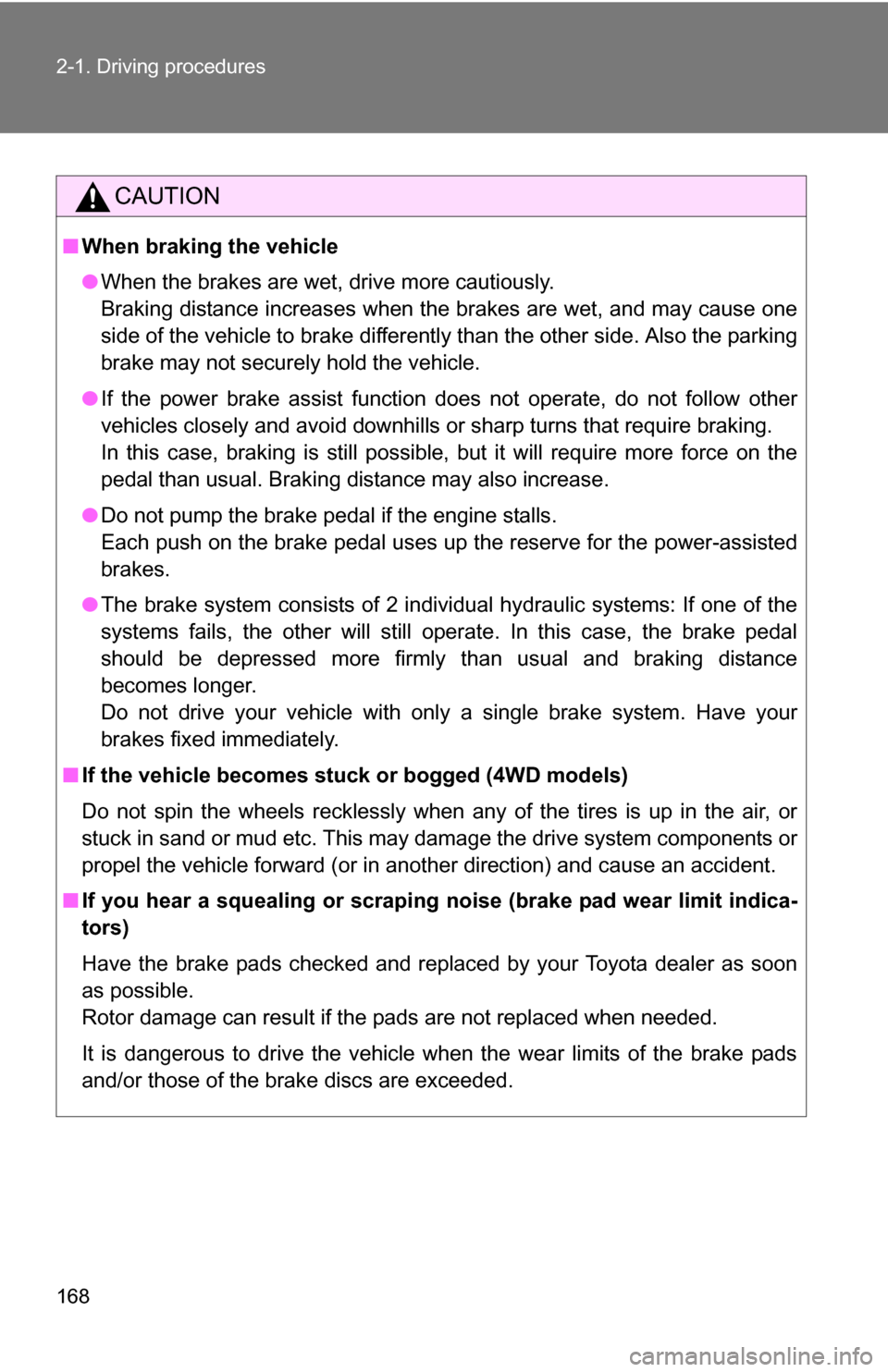
168 2-1. Driving procedures
CAUTION
■When braking the vehicle
●When the brakes are wet, drive more cautiously.
Braking distance increases when the brakes are wet, and may cause one
side of the vehicle to brake differently than the other side. Also the parking
brake may not securely hold the vehicle.
● If the power brake assist function does not operate, do not follow other
vehicles closely and avoid downhills or sharp turns that require braking.
In this case, braking is still possible, but it will require more force on the
pedal than usual. Braking distance may also increase.
● Do not pump the brake pedal if the engine stalls.
Each push on the brake pedal uses up the reserve for the power-assisted
brakes.
● The brake system consists of 2 individual hydraulic systems: If one of the
systems fails, the other will still operate. In this case, the brake pedal
should be depressed more firmly than usual and braking distance
becomes longer.
Do not drive your vehicle with only a single brake system. Have your
brakes fixed immediately.
■ If the vehicle becomes stu ck or bogged (4WD models)
Do not spin the wheels recklessly when any of the tires is up in the air, or
stuck in sand or mud etc. This may damage the drive system components or
propel the vehicle forward (or in another direction) and cause an accident.
■ If you hear a squealing or scrapin g noise (brake pad wear limit indica-
tors)
Have the brake pads checked and replaced by your Toyota dealer as soon
as possible.
Rotor damage can result if the pads are not replaced when needed.
It is dangerous to drive the vehicle when the wear limits of the brake pads
and/or those of the brake discs are exceeded.
Page 232 of 684
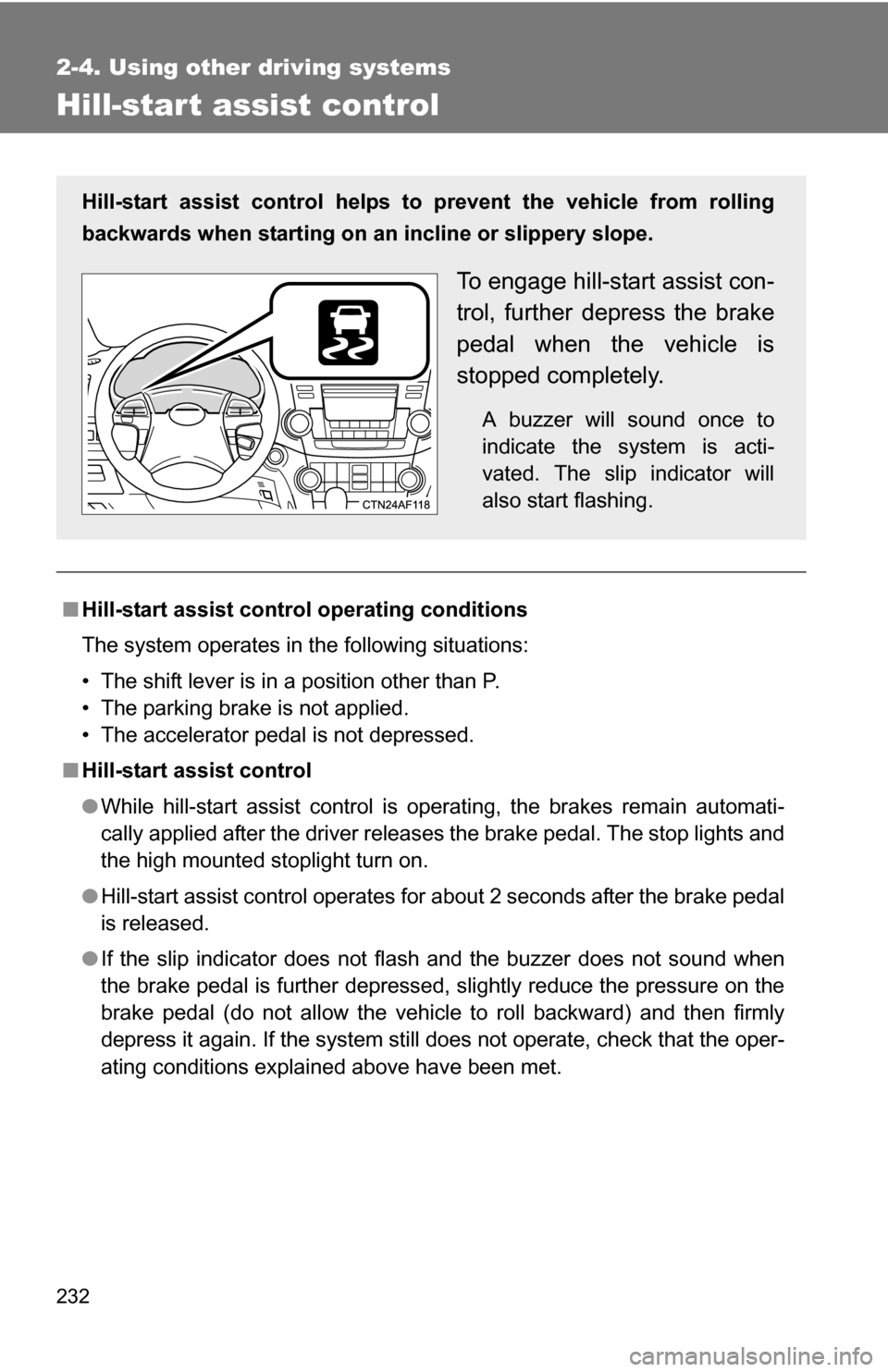
232
2-4. Using other driving systems
Hill-start assist control
■Hill-start assist control operating conditions
The system operates in the following situations:
• The shift lever is in a position other than P.
• The parking brake is not applied.
• The accelerator pedal is not depressed.
■ Hill-start assist control
●While hill-start assist control is operating, the brakes remain automati-
cally applied after the driver releases the brake pedal. The stop lights and
the high mounted stoplight turn on.
● Hill-start assist control operates for about 2 seconds after the brake pedal
is released.
● If the slip indicator does not flash and the buzzer does not sound when
the brake pedal is further depressed, slightly reduce the pressure on the
brake pedal (do not allow the vehicl e to roll backward) and then firmly
depress it again. If the system still does not operate, check that the oper-
ating conditions explained above have been met.
Hill-start assist control helps to prevent the vehicle from rolling
backwards when starting on an incline or slippery slope.
To engage hill-start assist con-
trol, further depress the brake
pedal when the vehicle is
stopped completely.
A buzzer will sound once to
indicate the system is acti-
vated. The slip indicator will
also start flashing.
Page 233 of 684
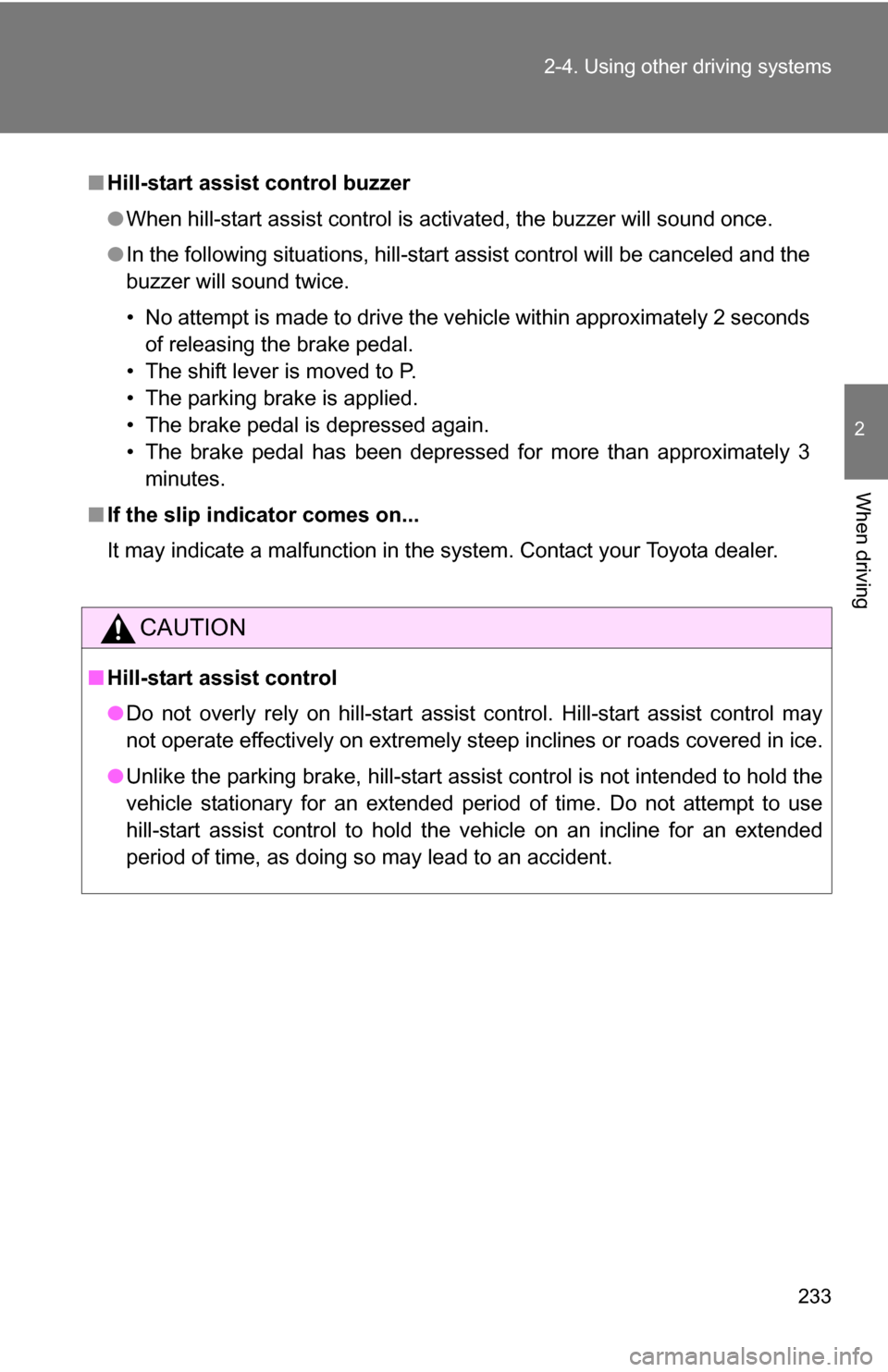
233
2-4. Using other
driving systems
2
When driving
■Hill-start assist control buzzer
●When hill-start assist control is activated, the buzzer will sound once.
● In the following situations, hill-start assist control will be canceled and the
buzzer will sound twice.
• No attempt is made to drive the vehicle within approximately 2 seconds
of releasing the brake pedal.
• The shift lever is moved to P.
• The parking brake is applied.
• The brake pedal is depressed again.
• The brake pedal has been depressed for more than approximately 3 minutes.
■ If the slip indicator comes on...
It may indicate a malfunction in the system. Contact your Toyota dealer.
CAUTION
■Hill-start assist control
●Do not overly rely on hill-start assist control. Hill-start assist control may
not operate effectively on extremely steep inclines or roads covered in ice.
● Unlike the parking brake, hill-start assist control is not intended to hold the
vehicle stationary for an extended period of time. Do not attempt to use
hill-start assist control to hold the vehicle on an incline for an extended
period of time, as doing so may lead to an accident.
Page 671 of 684
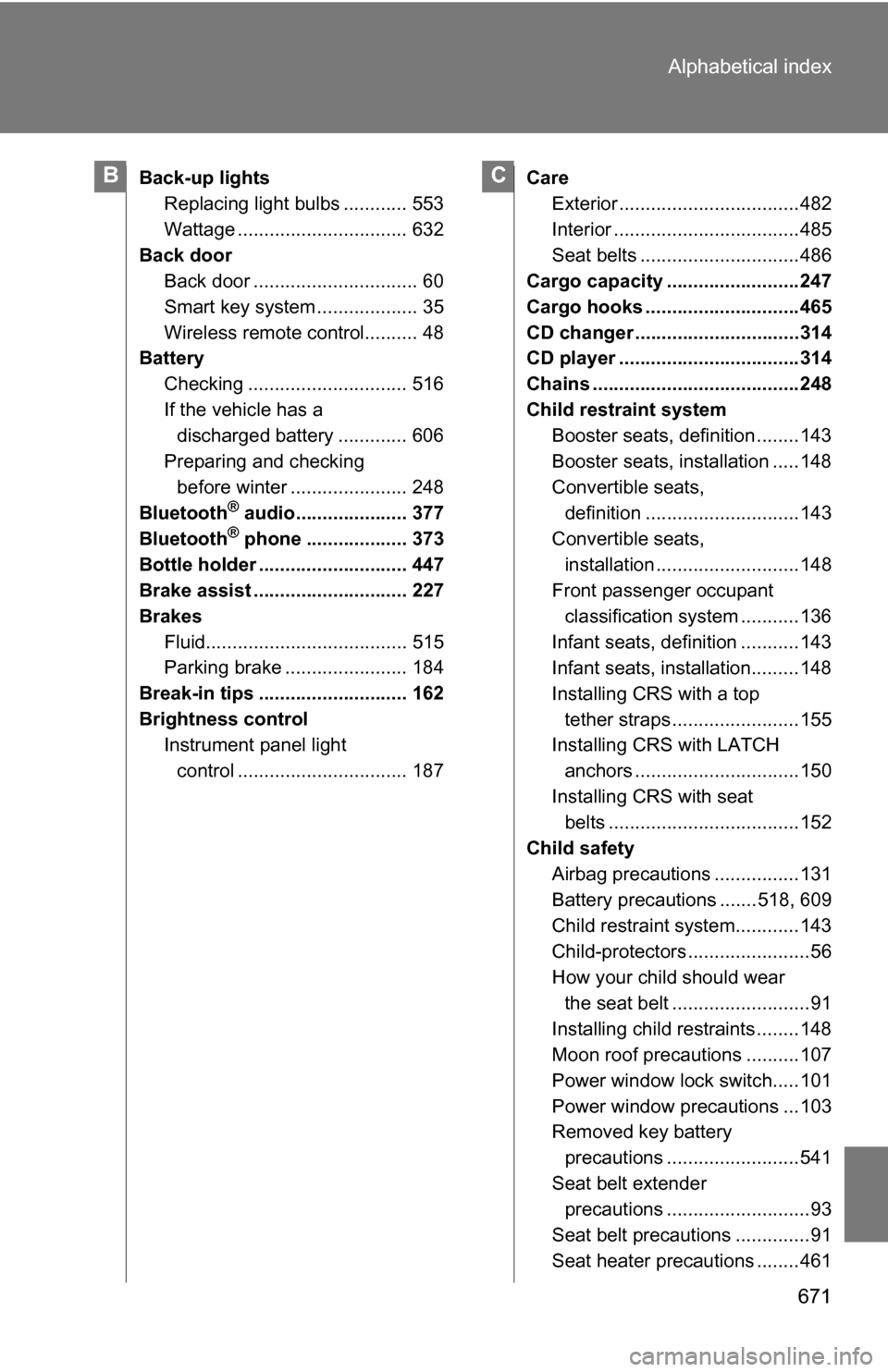
671
Alphabetical index
Back-up lights
Replacing light bulbs ............ 553
Wattage ................................ 632
Back door Back door ............................... 60
Smart key system ... ................ 35
Wireless remote control.......... 48
Battery
Checking .............................. 516
If the vehicle has a discharged battery ............. 606
Preparing and checking before winter ...................... 248
Bluetooth
® audio..................... 377
Bluetooth® phone ................... 373
Bottle holder ............................ 447
Brake assist ............................. 227
Brakes Fluid...................................... 515
Parking brake ....................... 184
Break-in tips ............................ 162
Brightness control Instrument panel light
control ................................ 187 Care
Exterior ..................................482
Interior ...................................485
Seat belts ..............................486
Cargo capacity .........................247
Cargo hooks .............................465
CD changer ...............................314
CD player ..................................314
Chains .......................................248
Child restraint system Booster seats, definition ........143
Booster seats, installation .....148
Convertible seats, definition .............................143
Convertible seats, installation ...........................148
Front passenger occupant
classification system ........... 136
Infant seats, definition ...........143
Infant seats, installation.........148
Installing CRS with a top tether straps ........................155
Installing CRS with LATCH
anchors ...............................150
Installing CRS with seat belts ....................................152
Child safety Airbag precautions ................131
Battery precautions .......518, 609
Child restraint system............143
Child-protectors .......................56
How your child should wear the seat belt ..........................91
Installing child restraints ........148
Moon roof precautions ..........107
Power window lock switch.....101
Power window precautions ...103
Removed key battery precautions .........................541
Seat belt extender precautions ...........................93
Seat belt precautions ..............91
Seat heater precautions ........461
BC